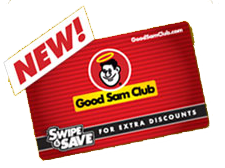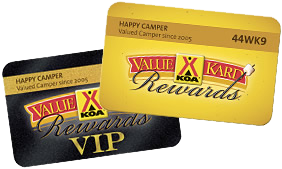Anybody who has been in business for more than a month knows that it is far easier to get a repeat sale from an existing customer than it is to generate a new customer from scratch. As long as you provide a positive experience at the time of stay, and a first-time camper enjoys the company of his fellow guests, your main task is to simply invite him to return. Most of us have preferred “go to” businesses for almost everything in life. We do the bulk of our food shopping at one supermarket, have one favorite restaurant, and have a long list of preferred providers of a wide range of products and services – from auto mechanics to hair stylists, from dentists to cell phone service providers. What you want to become is the “go to” place for camping.
Catering to your existing clientele in order to generate repeat business is nothing new, but some businesses and industries have capitalized upon this concept better than others. For years, airlines have teamed up with credit card companies to offer frequent flyer programs, creating an unprecedented brand loyalty in a market that is otherwise highly price-sensitive. Supermarkets and pharmacy chains have reward cards that encourage repeat purchases and offer product discounts. Then, of course, is the highly competitive credit card industry itself. One thing that they almost all have in common is a plastic card that implies some sort of exclusivity and “membership”.
The Card Is the Key
The Good Sam Club and its accompanying card have been around for years. For as little as $22.00 per year, members get a 10% discount at participating Good Sam campgrounds, discounts on RV parts and accessories at Camping World, discounts on fuel purchases at Pilot and Flying J stations, and other less directly monetary benefits. KOA, on the other hand, offers its KOA Value Kard Rewards program. For $24.00 for the first year, participants get a 10% discount on registration fees at KOA campgrounds and earn points that can be redeemed for camping rewards. After earning 20,000 points, memberships are automatically upgraded to VIP status, which accelerates the earning of additional points. There are many other camping discount and membership rewards programs within the industry, including Passport America, Camp Club USA, and membership campgrounds like Thousand Trails. The latest player is the AmeriGO RV Club, offering the same sort of 10% discount on stays at affiliated campgrounds, along with other values, for an introductory annual membership fee of only $9.95.
To succeed at this concept, you do not need to belong to a group or a franchise. Your goal is simply to generate repeat business for your individual park. In fact, it may not be necessary to offer your customers a discount on registration fees to lure their repeat business. After all, if a 10% discount becomes too commonplace, it loses its perceived value altogether. Let’s look outside the camping industry to see how to make the customer rewards concept work as productively as possible.
Amazon Prime
Amazon Prime is a membership program that the online marketing behemoth launched back in 2004. The $79.00 per year bundle offers free streaming of more than 40,000 movies and TV shows (which capitalize upon the bandwidth that Amazon has at its disposal – through its Amazon Web Services division, the world’s largest Internet hosting services provider), free e-books (which help to spur sales of its Kindle readers), and – most importantly – free 2-day shipping on unlimited purchases of millions, without a minimum order size. Bingo! Shipping costs have always been the biggest barrier to online commerce, with free shipping the means to dramatically increased sales.
According to a recent article in the online edition of Forbes Magazine, even with Amazon’s logistical efficiencies and exclusive volume discounts with UPS and FedEx, the company loses money on its Prime program. On the surface. With over 20 million members (many lured in by the free 30-day trial program during the checkout process at the time of purchase), the Amazon Prime program has created a “go to” mindset that makes Amazon the first (and presumably only) place for its members to order merchandise online. According to Amazon, over 1 million buyers joined the program during the third week of December 2013 alone. Most are attracted by the free shipping, and Amazon reaps the rewards.
According to a recent report from Consumer Intelligence Research Partners, the average Amazon Prime customer spent over $1,300.00 with Amazon.com last year, as opposed to the average Amazon customer who is not a member of the Prime program spending about $600.00. Amazon is continually willing to experiment with its program, currently contemplating an increase in the annual fee, while extending the concept into its Prime Fresh discount, same-day produce and grocery delivery program being tested in Los Angeles, San Francisco and Seattle.
That’s Amazon.
What About Your Campground?
First of all, determine that you are already doing everything possible to generate repeat business before creating a rewards program. The following are prerequisites:
- When guests check out, do you ask them if you can book their next stay? Right then, before they leave.
- Do you maintain a database of your active customers? These are probably people who have camped with you within the past two or three years, flagging guests who have already stayed multiple times.
- Are you maintaining an e-mail marketing program and a direct mail program to reach out to these key customers both prior to the season and during any slumps within the season? Even a simple (and inexpensive) postcard, summarizing your weekend activities and mailed out during the winter months (for campgrounds in the North), can trigger early event-based reservations.
- Do you have social media programs in place, particularly on Facebook and Twitter? Engage your followers, and encourage them to become a part of upcoming events.
Only once those prerequisites have been covered is it time to consider launching a rewards program. When you are ready, give your concept some serious thought to ensure the maximum success.
- Order professionally designed plastic cards. They cost far less than you may think, and they provide a tangible sense of membership and belonging.
- Determine the annual fee that you will charge for your program. It is entirely conceivable that you could provide your program for free; however, I would strongly encourage a fee-based program that will at least cover your administrative costs and a portion of the anticipated income lost from the rewards that will be offered. On one hand, you do not want to discourage participation by charging too high a fee; on the other hand, keep in mind that a paid service will intuitively have greater perceived value than an identical free service. The perfect balance will be a fee that users feel they will easily recover while enjoying added benefits from the program.
- Allow people to sign up for your rewards program, immediately obtaining benefits, at the time of reservation and at the time of registration. The annual fee that you charge will represent immediate income.
- Determine what you will offer as the key benefits of your rewards program, based upon both your profit margins and specific products and services that have significant perceived value among your guests. I cannot overemphasize that it is not necessary to offer a discount on camping.
- Potential rewards might include express check-in, free site upgrades (if available), points toward a free future stay, waivers of early check-in and late check-out fees (based upon availability), discounts in your store and snack bar, free wi-fi or dump station services (if these are otherwise fee-based), discounts on things like mini-golf and boat rentals, a waiver of guest fees, free morning coffee in your store, and discounts for nearby businesses.
- Be willing to experiment by changing your reward program’s benefits from year to year, based upon customer response and feedback.
Think about the types of benefits that will appeal to your customers, but also keep in mind the proven concepts that are working for others, most notably the examples and lessons to be learned from Amazon Prime. By offering free coffee or a store discount, you are getting people into your store, where they will buy merchandise, move inventory, and increase high profit margin sales. By offering free early check-in, you will stagger arrivals and reduce registration lines and the stress level of your staff. By waiving guest fees, you may be introducing your park to its next paying campers. And by offering discounts to local businesses, you open the doors to a wide range of reciprocal and cross-promotional possibilities. Imagine if, like Amazon, you could get your typical rewards program member to spend more than twice as much with you each year than your conventional campers. That would be a profitable program indeed!
This post was written by Peter Pelland



